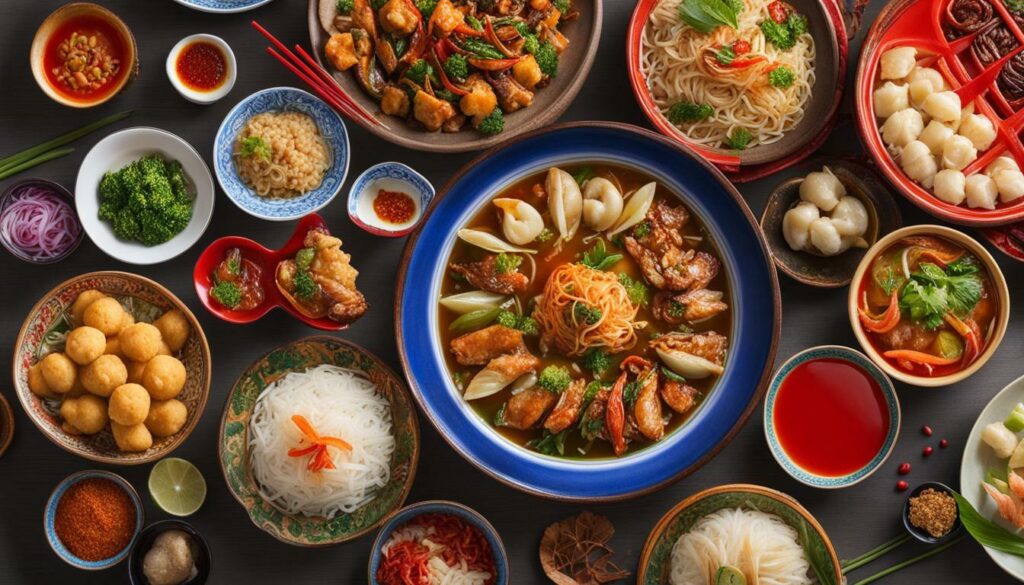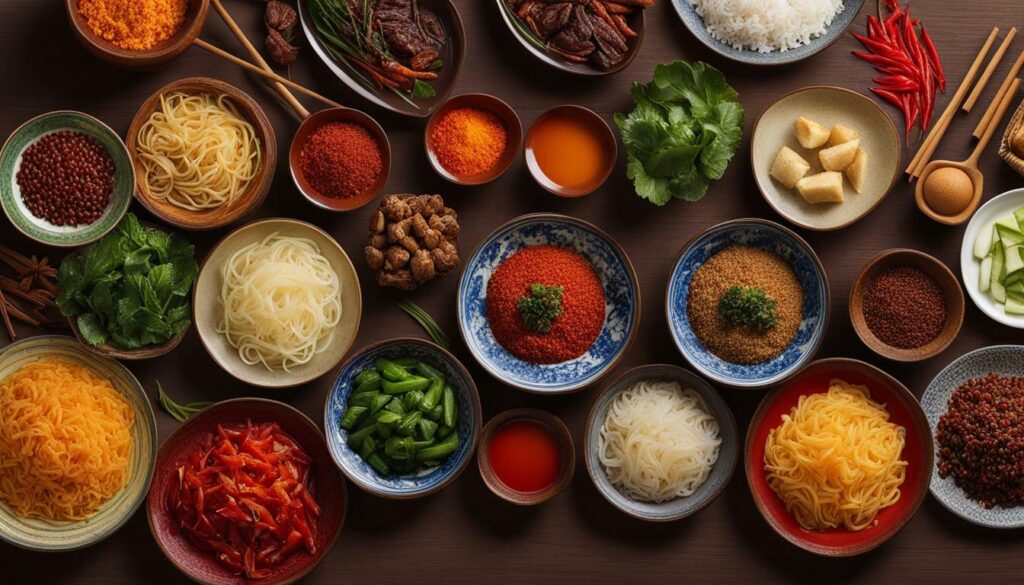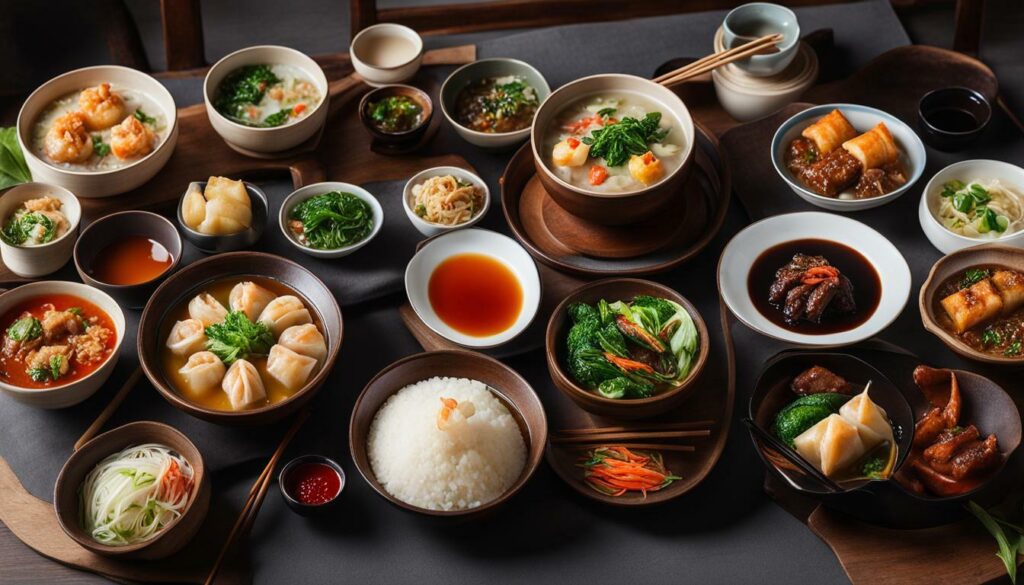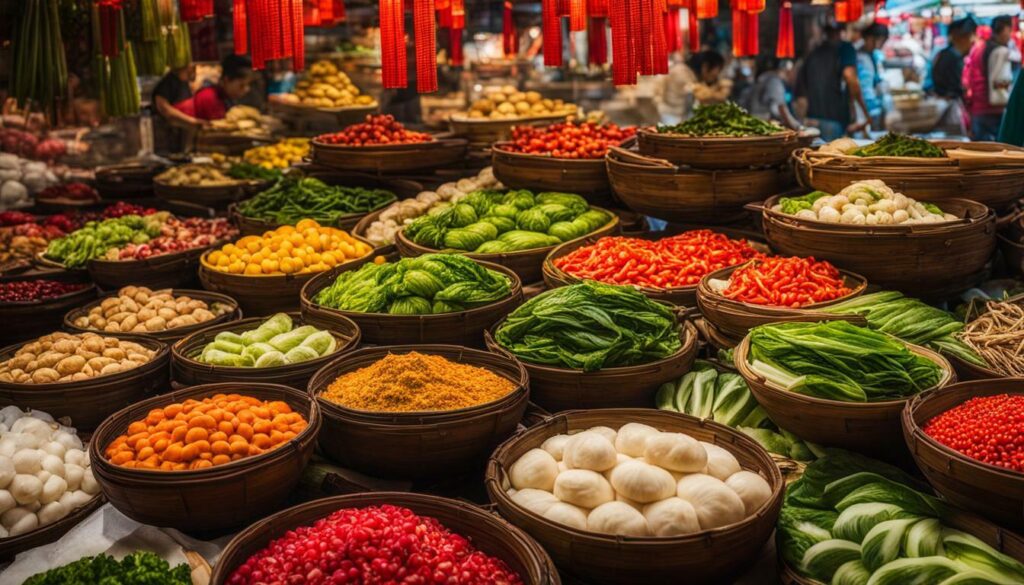China’s rich culinary heritage is a reflection of its diverse history and cultural traditions, with past and present diets showcasing a fascinating journey through time. From ancient times to modernity, Chinese food has evolved, influenced by economic development, health concerns, regional variations, and government initiatives. Understanding the history and significance of food in China provides valuable insights into the nation’s culture and health landscape.
Key Takeaways:
- Past and present diets in China have undergone significant changes due to economic development.
- Traditional foods play a crucial role in Chinese culinary heritage and national identity.
- The rise in obesity and lifestyle diseases presents health concerns in China.
- The Chinese government is taking measures to improve food security and promote healthier eating habits.
- Regional variations in eating habits reflect China’s diverse food culture.
Traditional Foods of China: A Glimpse into the Past
Traditional foods hold a special place in China’s culinary landscape, representing the nation’s cultural identity and heritage. Through centuries of rich history, China has developed a diverse and vibrant food culture, with each region boasting its own unique culinary traditions.
One of the most renowned traditional foods in China is Peking duck, a dish that originated in Beijing during the Ming Dynasty. Known for its thin, crispy skin and tender meat, it is typically served with pancakes, scallions, and hoisin sauce. Peking duck has become a national dish in China, symbolizing the country’s gastronomic excellence.
Another beloved traditional food is dim sum, a style of cuisine that originated in southern China. Dim sum refers to a variety of bite-sized dishes served in steamer baskets or on small plates. It is a popular choice for breakfast or brunch and often includes items such as dumplings, buns, and rice rolls. Dim sum has gained international recognition for its delicate flavours and artful presentation.
| Traditional China Foods | Traditional Foods of China | China National Food | National Dish in China |
|---|---|---|---|
| Peking duck | Dim sum | Kung Pao chicken | Sweet and sour pork |
| Hot pot | Mapo tofu | Spring rolls | Fried rice |
As China has experienced rapid economic development, the traditional foods of the past have evolved to include new influences and flavours. While these modern adaptations have added diversity to Chinese cuisine, it is essential to preserve the essence of traditional foods to maintain cultural connections and appreciate the historical significance of China’s culinary heritage.
The cultural, regional, and historical importance of traditional foods in China cannot be understated. They are not merely meals but rather symbols of national pride, cherished recipes passed down through generations. By embracing and savouring these traditional foods, one can embark on a culinary journey that reveals the rich tapestry of Chinese culture.
Chinese Street Food – Video Tour
Evolution of Chinese Diets: Impact of Economic Development
The rapid economic development in China has brought about significant changes in the country’s food habits and culinary preferences. Traditional diets, which once consisted of staple foods like rice, vegetables, and soy-based products, have undergone a transformation. With increased prosperity, a greater variety of foods has become accessible, leading to a shift towards diets that are higher in salt, fat, sugar, and animal products.
This change in dietary patterns has had both positive and negative implications for the health of the Chinese population. While undernutrition has become rare, there has been a concerning rise in obesity, high cholesterol, and Type 2 Diabetes. The availability of processed and fast foods, coupled with sedentary lifestyles, has contributed to these health issues.
To address these concerns, the Chinese government has implemented various initiatives aimed at improving food security and promoting healthier eating habits. These initiatives include education campaigns, the establishment of nutrition guidelines, and the promotion of sustainable and low-carbon diets. Additionally, the government has emphasized the preservation of traditional food cultures while encouraging the adoption of dietary guidelines that align with both cultural and nutritional goals.
It is crucial to recognize the regional variations in eating habits across China. Different provinces and cities have their own unique culinary traditions and preferences. While some regions may favour seafood, others may specialize in spicy dishes or vegetarian cuisine. Understanding and embracing this diversity is essential for appreciating China’s rich food culture.
Ultimately, the evolution of Chinese diets reflects the complex interplay between economic development, cultural heritage, and health concerns. By promoting a balanced diet that incorporates traditional foods and aligns with nutritional goals, China can ensure that its people maintain good health and preserve its culinary heritage for future generations.
Table: Traditional and Modern Chinese Diets
| Traditional Chinese Diet | Modern Chinese Diet |
|---|---|
| Staple foods: rice, noodles, and millet | Processed grains: white bread, instant noodles |
| Vegetables and legumes | Increased consumption of meat and animal products |
| Soy-based products: tofu, tempeh | Processed soy products: soy-based desserts, soy milk |
| Minimal use of added sugars and oils | High intake of added sugars and oils in processed foods |
Health Concerns: Rising Obesity and Diseases
As Chinese diets have transitioned towards modern eating patterns, concerns over health issues such as obesity and related diseases have become more prominent. Traditional diets, once centred around a variety of plant-based foods and relatively low in fat and sugar, have given way to diets higher in salt, fat, sugar, and animal products. This shift in dietary habits, coupled with sedentary lifestyles and increased urbanization, has contributed to a rise in obesity rates, high cholesterol, and the prevalence of Type 2 Diabetes in China.
According to recent research, the prevalence of obesity in China has more than doubled over the past three decades. This rapid increase in obesity has been attributed to the adoption of Western-style diets, characterized by the consumption of processed and high-calorie foods. These dietary changes, combined with the lack of physical activity, have created a concerning public health issue.
Furthermore, the rise in obesity has led to an increase in associated health problems, including cardiovascular diseases and metabolic disorders. High cholesterol levels, often a result of poor dietary choices, have become a common health concern in China. Additionally, the incidence of Type 2 Diabetes has surged, affecting millions of individuals in the country.
| Health Concerns | Prevalence |
|---|---|
| Obesity | Rapid increase over the past three decades |
| High Cholesterol | Common health concern |
| Type 2 Diabetes | Affecting millions of individuals |
The impact of these health concerns extends beyond individual well-being, as they also place a burden on healthcare systems and the economy. To address these issues, the Chinese government has implemented various initiatives to promote healthier eating habits and combat the rising rates of obesity and related diseases. These initiatives include educational campaigns, food labelling regulations, and promoting the consumption of traditional Chinese foods that are lower in fat, salt, and sugar.

“The changes in our diets over the years have had a significant impact on our health. With the adoption of more Westernized eating habits, we have seen a rise in obesity and related diseases. It is crucial for individuals to understand the importance of making healthier food choices and embracing traditional Chinese foods that nurture our bodies and promote well-being.”
In summary, the transition from traditional to modern diets in China has brought about significant health concerns, particularly in terms of rising obesity rates and related diseases. The Chinese government is actively taking steps to address these issues by promoting healthier eating habits and encouraging the consumption of traditional Chinese foods that align with both cultural and nutritional goals. By raising awareness and fostering behaviour change interventions, it is hoped that China’s population can embrace a balanced diet and reduce the prevalence of obesity and associated health problems.
Government Initiatives: Improving Food Security and Healthy Eating
Recognizing the need to address the changing dietary landscape, the Chinese government has implemented initiatives to ensure food security and encourage healthier food choices during festive celebrations. These efforts aim to strike a balance between preserving the fame of famous foods in China and promoting a more nutritious and sustainable food culture.
One of the key government programs is focused on improving food security across the nation. China has a large population to feed, and ensuring an adequate and safe food supply is crucial. The government has implemented strict regulations and standards to monitor the production, distribution, and quality of food products. By enforcing these measures, the government aims to reduce the risk of food contamination and protect public health.
In addition to food security, the Chinese government is also taking steps to promote healthier eating habits during festive occasions. Traditionally, festive foods in China tend to be high in calories, sugar, and unhealthy fats. To address this, the government has introduced guidelines and educational campaigns to encourage the consumption of healthier alternatives. This includes promoting the use of whole grains, fresh fruits and vegetables, and lean protein sources in festive meals.
| Festive Foods in China | Famous Foods in China |
|---|---|
| Spring Festival: Dumplings, fish, and glutinous rice cake | Peking Duck, Xiaolongbao, Gong Bao Chicken |
| Mid-Autumn Festival: Mooncakes, pomelos, and osmanthus cakes | Kung Pao Chicken, Mapo Tofu, Hot Pot |
| Dragon Boat Festival: Zongzi (sticky rice dumplings) | Sweet and Sour Pork, Beijing Kao Ya (Peking Roast Duck) |
Through these initiatives, the Chinese government aims to create a cultural shift towards healthier eating habits without disregarding the rich culinary heritage of the nation. By promoting food security and encouraging healthier choices during festive occasions, China seeks to preserve the fame of famous foods while also addressing health concerns and promoting a balanced diet.

Low-Carbon Development and Dietary Guidelines in China
China’s dietary guidelines play a crucial role in addressing not only health concerns but also environmental sustainability, shaping the country’s rich culinary heritage and famous food dishes. As the world’s most populous country, China faces unique challenges in promoting a sustainable and healthy food system. The government has implemented dietary guidelines that aim to reduce carbon emissions, promote sustainable food practices, and encourage a shift towards plant-based diets.
According to these guidelines, individuals are encouraged to consume a variety of nutrient-rich foods, including grains, vegetables, fruits, legumes, nuts, and seeds. These foods not only provide essential nutrients but also have a lower environmental impact compared to animal-based products. By promoting plant-based diets, China aims to reduce greenhouse gas emissions, conserve water resources, and protect biodiversity.
In addition to dietary recommendations, the guidelines also emphasize the need to reduce food waste and promote sustainable production and consumption. China has made significant progress in reducing food waste through education campaigns and innovative technologies. Furthermore, the guidelines encourage the consumption of locally sourced, seasonal foods, supporting local farmers and reducing the carbon footprint associated with long-distance food transportation.
Table: Environmental Impact of Different Food Groups
| Food Group | Environmental Impact |
|---|---|
| Fruits and Vegetables | Low |
| Grains and Legumes | Moderate |
| Poultry and Seafood | Moderate |
| Red Meat and Dairy | High |
China’s efforts towards low-carbon development and sustainable food practices have received international recognition. By aligning dietary guidelines with environmental goals, China is leading the way in promoting a more sustainable and healthy food system. However, the successful implementation of these guidelines relies on behavior change interventions and public awareness.
Overall, China’s commitment to low-carbon development and dietary guidelines not only addresses health concerns but also fosters a deep appreciation for the country’s diverse culinary heritage. By embracing these guidelines, individuals not only contribute to their own well-being but also play a part in preserving China’s rich food culture for future generations.

Regional Variations: Exploring China’s Diverse Food Culture
China’s vast geographical expanse gives rise to a remarkable diversity in regional food cultures, each with its own national food and culinary traditions. From the fiery and spicy dishes of Sichuan to the delicate and refined flavours of Cantonese cuisine, the regional variations in China’s food culture are a testament to its rich culinary heritage.
One of the most well-known regional cuisines in China is Sichuanese cuisine. Known for its bold and spicy flavours, Sichuanese dishes are often characterized by the use of Sichuan peppercorns, chilli peppers, and garlic. This cuisine is famous for its numbing and spicy sensation, which is achieved by the combination of these ingredients. Some popular Sichuanese dishes include Mapo Tofu, Kung Pao Chicken, and Twice-Cooked Pork.
On the other end of the spectrum, Cantonese cuisine is celebrated for its light and fresh flavours. Seafood is a prominent feature in Cantonese dishes, with steamed fish and dim sum being popular choices. Cantonese cuisine also places great emphasis on the quality of ingredients and the technique of cooking, resulting in dishes that are simple yet incredibly flavorful.
| Regional Cuisine | National Food | Culinary Traditions |
|---|---|---|
| Sichuan | Mapo Tofu | Spicy and bold flavours |
| Cantonese | Dim Sum | Light and fresh flavours |
Another notable regional cuisine in China is the cuisine of the Hakka people. Hailing from the southern provinces of Guangdong, Fujian, and Jiangxi, Hakka cuisine is known for its hearty and earthy flavours. Rice and noodles are staple foods in Hakka cuisine, and dishes such as Yong Tau Foo and Salt-Baked Chicken are popular examples.
The regional variations in China’s food culture not only showcase the diverse flavours and cooking techniques within the country but also reflect the cultural and historical influences of each region. Exploring these regional cuisines is a delightful journey that allows one to appreciate the rich tapestry of China’s culinary heritage.
Regional Variations: Highlights
- Sichuanese cuisine: Bold and spicy flavours, famous for dishes like Mapo Tofu and Kung Pao Chicken.
- Cantonese cuisine: Light and fresh flavours, renowned for its seafood and dim sum.
- Hakka cuisine: Hearty and earthy flavours, featuring dishes like Yong Tau Foo and Salt-Baked Chicken.

Cultural and Nutritional Balance: The Importance of a Balanced Diet
Striking a balance between cultural traditions and nutritional needs is essential in China’s vibrant food culture, where traditional foods continue to hold a special place. The rich history and diverse regional cuisines of China offer a wide array of flavours and ingredients that contribute to a balanced diet. Traditional foods in China, such as rice, noodles, soybeans, and leafy greens, are not only delicious but also packed with essential nutrients.
In recent years, as China has embraced economic development and urbanization, there has been a noticeable shift in dietary habits. Fast food, processed snacks, and sugary beverages have become more prevalent, leading to an increase in health concerns like obesity and diabetes. However, it is important to recognize that traditional foods can still play a significant role in maintaining a healthy lifestyle.
A balanced diet in China encompasses a mix of staple foods, including grains, vegetables, and proteins. It is characterized by moderation in portion sizes, mindful eating, and a focus on fresh, seasonal ingredients. By incorporating traditional foods into their daily meals, Chinese individuals can enjoy the taste of their cultural heritage while nourishing their bodies.

| Nutrient | Food Sources | Benefits |
|---|---|---|
| Protein | Lean meats, tofu, soy products | Building block for muscles, tissues, and hormones |
| Fiber | Whole grains, fruits, vegetables | Regulates digestion, reduces cholesterol, and promotes satiety |
| Omega-3 fatty acids | Fish, walnuts | Reduces inflammation and supports brain health |
| Vitamins and minerals | Leafy greens, citrus fruits | Supports immune function, bone health, and energy production |
By embracing traditional foods and incorporating them into a balanced diet, individuals in China can maintain cultural authenticity while making informed choices for their health and well-being. It is essential to celebrate the rich culinary heritage of China and ensure that future generations continue to appreciate and benefit from the nutritional value of traditional foods.
Behaviour Change Interventions: Encouraging Healthy Eating Habits
Encouraging healthy eating habits and promoting the consumption of traditional foods requires effective behaviour change interventions that consider the cultural context of Chinese cuisine. As China undergoes rapid economic development, there has been a shift in dietary preferences towards processed and convenience foods, leading to an increase in health concerns such as obesity and chronic diseases.
To tackle these challenges, the Chinese government has implemented various initiatives to promote healthier eating habits. One such initiative is the “National Action Plan for Nutrition Improvement (2017-2030)”, which aims to improve the nutrition status of the population and promote the consumption of traditional foods. The plan includes measures such as education campaigns, nutrition labelling, and incentives for food companies to develop healthier products.
Behaviour change interventions also play a crucial role in motivating individuals to adopt healthier eating habits. These interventions can take various forms, including educational programs, social marketing campaigns, and community-based initiatives. By raising awareness about the benefits of traditional foods and providing practical guidance on how to incorporate them into daily meals, these interventions empower individuals to make informed choices for their health.
Key Strategies for Behavior Change Interventions:
- Providing culturally appropriate nutrition education: Customizing nutrition education to reflect cultural practices and beliefs can enhance the acceptability and effectiveness of interventions. This includes emphasizing the value of traditional foods and their role in maintaining health.
- Promoting culinary skills and food preparation: Encouraging individuals to cook their meals using fresh ingredients and traditional cooking methods can enhance their connection to cultural heritage and promote healthier food choices.
- Creating supportive environments: Making healthy food options more accessible and affordable in schools, workplaces, and public spaces can facilitate behavior change. It also involves creating social norms that support healthy eating habits.
As behaviour change interventions continue to evolve and adapt to the changing food landscape in China, it is essential to ensure that they are culturally sensitive, evidence-based, and sustainable over the long term. By empowering individuals and communities to embrace healthier eating habits while celebrating the rich culinary traditions of China, these interventions can contribute to a healthier future for all.
| Key Strategies for Behavior Change Interventions | |
|---|---|
| Providing culturally appropriate nutrition education | Customizing nutrition education to reflect cultural practices and beliefs can enhance the acceptability and effectiveness of interventions. This includes emphasizing the value of traditional foods and their role in maintaining health. |
| Promoting culinary skills and food preparation | Encouraging individuals to cook their meals using fresh ingredients and traditional cooking methods can enhance their connection to cultural heritage and promote healthier food choices. |
| Creating supportive environments | Making healthy food options more accessible and affordable in schools, workplaces, and public spaces can facilitate behavior change. It also involves creating social norms that support healthy eating habits. |

Conclusion
By exploring the past and present diets of China, we gain valuable insights into the cultural significance of traditional foods, the impact of economic development, and the importance of promoting healthier eating habits for future generations.
Over time, China has witnessed significant shifts in its dietary trends, with traditional diets giving way to modern cuisine that is higher in salt, fat, sugar, and animal products. While undernutrition is now rare, the rise in obesity, high cholesterol, and Type 2 Diabetes is a cause for concern.
To address these health concerns, the Chinese government has taken proactive measures to improve food security and encourage healthier eating habits. Initiatives have been implemented to safeguard the availability and accessibility of traditional foods, especially during festive occasions, while also promoting the adoption of dietary guidelines that support low-carbon development and sustainable food practices.
However, achieving widespread behavioural change in eating habits is a challenge. Behaviour change interventions are crucial to encourage individuals to embrace traditional foods and align their diets with both cultural traditions and nutritional goals. By incorporating these interventions, future generations can benefit from a balanced diet that respects the cultural heritage of China while promoting optimal health and well-being.
FAQ
What are the main changes in Chinese diets due to economic development?
Chinese diets have undergone significant changes due to economic development, with traditional diets being replaced by diets higher in salt, fat, sugar, and animal products.
What are the health concerns associated with changing Chinese diets?
The rise in obesity, high cholesterol, and Type 2 Diabetes is a concern in China, highlighting the negative health impacts of changing diets.
How is the Chinese government addressing these changes in diets?
The Chinese government has implemented measures to improve food security and promote healthier eating habits in response to the changes in diets.
How do China’s dietary guidelines impact low-carbon development?
China’s dietary guidelines aim to promote low-carbon development by encouraging sustainable food practices and reducing environmental impacts.
What are the regional variations in eating habits across China?
Eating habits vary across different regions in China, reflecting the diverse food cultures within the country.
How important is a balanced diet in Chinese food culture?
Maintaining a balance between cultural traditions and nutritional goals is important in Chinese food culture, emphasizing the significance of a balanced diet.
What interventions are needed to encourage healthy eating habits in China?
Behaviour change interventions are crucial in promoting healthier eating habits and encouraging the widespread adoption of traditional foods and dietary guidelines in China.
Source Links
- https://www.wri.org/insights/china-dietary-guidelines-behavior-science-healthy-sustainable-diet
- https://www.ncbi.nlm.nih.gov/pmc/articles/PMC7432933/
- https://www.ncbi.nlm.nih.gov/pmc/articles/PMC8780919/



